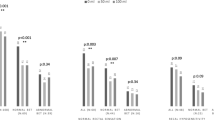Purpose
Anal pathology occurs in 20 to 80 percent of patients with Crohn’s disease in which abscesses, fistulas, and fissures account for considerable morbidity. The etiology is not clearly defined, but altered anorectal pressures may play a role. This study was designed to investigate anorectal physiologic conditions in patients with Crohn’s disease compared with healthy controls. METHODS: Twenty patients with Crohn’s disease located in the ileum (n = 9) or the colon (n = 11) without macroscopic proctitis or perianal disease were included. All were subjected to rectal examination, anorectal manometry, manovolumetry, and rectoscopy. Comparison was made with a reference group of 173 healthy controls of whom 128 underwent anorectal manometry, 29 manovolumetry, and 16 both examinations. RESULTS: Maximum resting pressure and resting pressure area were higher in patients than in controls (P = 0.017 and P = 0.011, respectively), whereas maximum squeeze pressure and squeeze pressure area were similar. Rectal sensitivity was increased in patients expressed as lower values both for volume and pressure for urge (P = 0.013 and P = 0.014, respectively) as well as maximum tolerable pressure (P = 0.025). CONCLUSIONS: This study demonstrates how patients with Crohn’s disease without macroscopic proctitis have increased anal pressures in conjunction with increased rectal sensitivity. This may contribute to later development of anal pathology, because increased intra-anal pressures may compromise anal circulation, causing fissures, and also discharging of fecal matter into the perirectal tracts, which may have a role in infection and fistula development.
Similar content being viewed by others
References
Hellers G, Bergstrand O, Ewerth S, Holmstrom B. Occurrence and outcome after primary treatment of anal fistulae in Crohn’s disease. Gut 1980;21:525–7.
Lockhart-Mummery HE. Anal lesions in Crohn’s disease. Br J Surg 1985;72(Suppl):S95–6.
Lockhart-Mummery HE. Anal lesions in Crohn’s disease. Clin Gastroenterol 1972;1:377–91.
Buchmann P, Alexander-Williams J. Classification of perianal Crohn’s disease. Clin Gastroenterol 1980;9:323–30.
Pescatori M, Interisano A, Basso L,et al. Management of perianal Crohn’s disease. Results of a multicenter study in Italy. Dis Colon Rectum 1995;38:121–4.
Hughes LE. Surgical pathology and management of anorectal Crohn’s disease. J R Soc Med 1978;71:644–51.
Allan A, Keighley MR. Management of perianal Crohn’s disease. World J Surg 1988;12:198–202.
Lennard-Jones JE. Classification of inflammatory bowel disease. Scand J Gastroenterol 1989;170(Suppl):2–6.
Best W, Becktel J. The Crohn’s disease activity as a clinical instrument. In: Pena A, Weterman I, Booth C, Strober W, eds. Recent advances in Crohn’s disease. The Hague: Martinus Nijhoff, 1981:7–12.
Sundblad M, Hallbook O, Sjodahl R. Anorectal manometry with a microtransducer. Eur J Surg 1993; 159:365–70.
Hallbook O, Sjodahl R. The pressure area: a variable for the assessment of anal sphincter function. Eur J Surg 1995;l6l:603–6.
Akervall S, Fasth S, Nordgren S, Oresland T, Hulten L. Manovolumetry: a new method for investigation of anorectal function. Gut 1988;29:6l4–23.
Hallbook O, Sjodahl R. Techniques of rectal compliance measurement. Semin Colon Rectal Surg 1992;3:88–91.
Hallbook O, Sjodahl R. Surgical approaches to obtaining optimal bowel function. Semin Surg Oncol 2000; 18:249–58.
Bernstein CN, Niazi N, Robert M,et al. Rectal afferent function in patients with inflammatory and functional intestinal disorders. Pain 1996;66:151–6l.
Kangas E, Hiltunen KM, Matikainen M. Anorectal function in Crohn’s disease. Ann Chir Gynaecol 1992;81:43–7.
Mueller MH, Kreis ME, Gross ML, Becker HD, Zittel TT, Jehle EC. Anorectal functional disorders in the absence of anorectal inflammation in patients with Crohn’s disease. Br J Surg 2002;89:1027–31.
Chrysos E, Athanasakis E, Tsiaoussis J,et al. Rectoanal motility in Crohn’s disease patients. Dis Colon Rectum 2001;44:1509–13.
Buchmann P, Mogg GA, Alexander-Williams J, Allan RN, Keighley MR. Relationship of proctitis and rectal capacity in Crohn’s disease. Gut 1980;21:137–40.
Felt-Bersma RJ, Sloots CE, Poen AC, Cuesta MA, Meuwissen SG. Rectal compliance as a routine measurement: extreme volumes have direct clinical impact and normal volumes exclude rectum as a problem. Dis Colon Rectum 2000;43:1732–8.
Gibbons CP, Read NW. Anal hypertonia in fissures: cause or effect? Br J Surg 1986;73:443–5.
Klosterhalfen B, Vogel P, Rixen H, Mittermayer C. Topography of the inferior rectal artery: a possible cause of chronic, primary anal fissure. Dis Colon Rectum 1989;32:43–52.
Schouten WR, Briel JW, Auwerda JJ. Relationship between anal pressure and anodermal blood flow. The vascular pathogenesis of anal fissures. Dis Colon Rectum 1994;37:664–9.
Mayer EA, Raybould H, Koelbel C. Neuropeptides, inflammation, and motility. Dig Dis Sci 1988;33(Suppl):71S-7S.
Heuman R, Bolin T, Sjodahl R, Tagesson C. The incidence and course of perianal complications and arthralgia after intestinal resection with restoration of continuity for Crohn’s disease. Br J Surg 1981;68:528–30.
Author information
Authors and Affiliations
Additional information
Supported by grants from the Swedish Society of Medicine, Ihrefoundation
About this article
Cite this article
Andersson, P., Olaison, G., Hallböök, O. et al. Increased anal resting pressure and rectal sensitivity in crohn’s disease. Dis Colon Rectum 46, 1685–1689 (2003). https://doi.org/10.1007/BF02660776
Issue Date:
DOI: https://doi.org/10.1007/BF02660776




